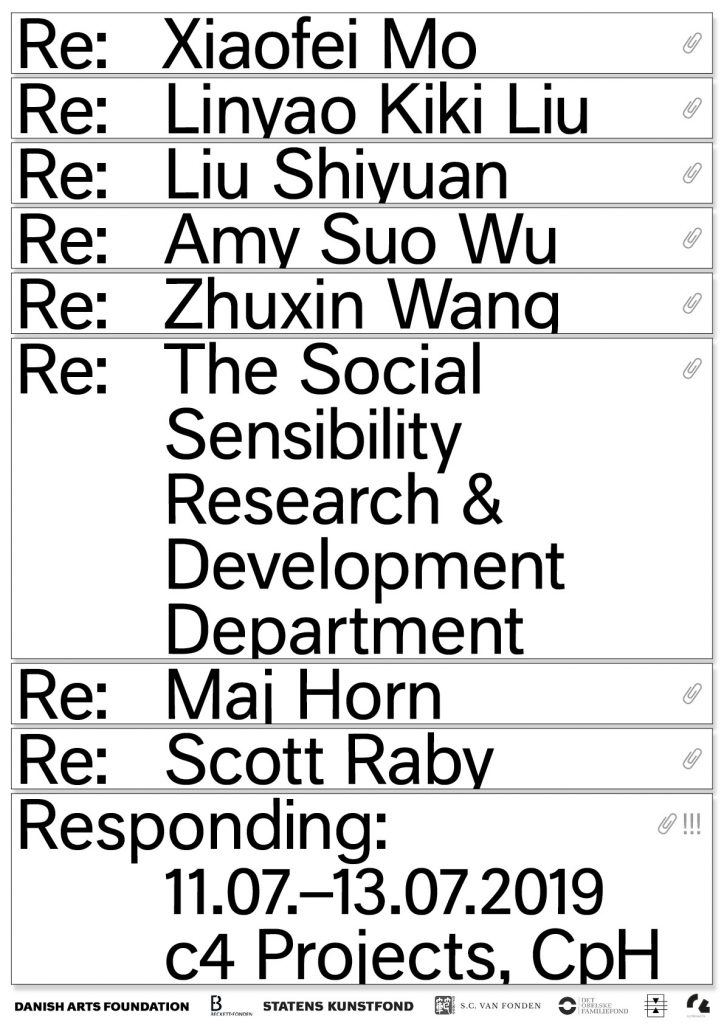Responding
A group exhibition with Liu Shiyuan, Xiaofei Mo, Linyao Kiki Liu, Amy Suo Wu, Zhuxin Wang, Maj Horn, Scott William Raby, and The Social Sensibility Research & Development Department
PROGRAM
Thursday 11th July 5-8 pm.:
Opening
Talk with The Social Sensibility R & D Department
Performative Lecture by Scott William Raby
Friday 12th July 4-6 pm.:
Love Poem reading with Liu Shiyuan
Saturday 13th July 2 – 7 pm.:
Shimo spreadsheet performance by Zhuxin Wang
Presentation of the project Walls and Walnuts by Maj Horn in conversation with Anna-Viktoria Eschbach
Many-voiced, Responding enlists the power of fragments as points of provocation to engage with methodologies of the contemporary.
Responding consists of both a series of public fragments, in which several of the research-based art projects will surface through presentations and performative gestures, while other projects will be presented in the space in the form of exhibition fragments.
The exhibition Responding is organized by Antonie Angerer & Anna-Viktoria Eschbach, founders and directors of the independent art space I: project space and is a curatorial reply to elements of the research that was executed during the first phase of the project Response in Beijing.
Response was a multi-faceted art project organized by the Danish collective COPING – which is an acronym of the two main cities involved in the exchange, Copenhagen and Beijing. The first iteration of the project took place in 2018 and consisted of an art exhibition and one-month residency in Beijing at I: project space with the artist Johannes Sivertsen, Astrid Myntekær, Sif Hedegård, Nanna Lysholt Hansen, Maj Horn, Scott William Raby, Ditte Soria, and Rikke Ehlers Nilsson. The project was initiated to work around the concepts of translations and establishing a trans-cultural dialogue, by investigating the visual cultures of both cities in a co-production approach. Building on this experience, c4 projects has invited I: project space to organize an exhibition which takes into consideration the artistic relationships developed and discussions that were conducted together with local Beijing artists during their stay in Beijing.
The exhibition is kindly supported by S.C. van Fonden, The Danish Arts Foundation, The Copenhagen Municipality’s Council of Visual Arts, Det Obelske Familiefond, and Beckett Fonden.
About the participating artists and projects:
Liu Shiyuan lives and works in Copenhagen and Beijing, China. Having grown up in China during a phase of unprecedented technological advances, global commercialization and popular culture assimilation, and later traveling and living between China, US, and Europe, Liu adapted and cultivated an innate sensibility unique to the contemporary Chinese diaspora. Liu’s practice explores a complex, transcultural identity confusion – a lack of any specific identity confinement, so to speak, wherein one’s lived experience and self-understanding derive from fluctuating components of rationality and mystery, reality and fiction.
Xiaofei Mo lives and works in New York, United States. Following in the footsteps of Alekseĭ Matveevich Pozdneev year-long expedition from China and Mongolia, traveling through the vast region extending from Beijing to Zhangjiakou, Xiaofei Mo studied the many sites along the route – such as Xiguanshi, Juyong Pass, Chadaocheng, Xuanhua, and others – that Pozdneev describes. The outcome is a new travelogue co-produced by the artist and POND, an AI – a “foreign object” – capable of captioning and annotating images. The goal here is to try to develop a way of seeing from the outside, to generate a voice that can only be understood as foreign and alien, from which perhaps an understanding of what lies beyond might become possible.
Linyao Kiki Liu lives and works in Beijing, China. Linyao Kiki Liu is using the subjective power of painting as the ultimate expression. Deleuze sought to defend the truth of painting on the grounds of its immediate, and hence non-manipulatable, corporeality. Liu’s paintings are a naked portrayal of the ones closest to her. Unmanipulated tenderness exposed in her use of brush strokes and color.
Amy Suo Wu lives and works in Rotterdam, the Netherlands. Since 2015, Wu has explored steganography, a form of secret writing that hides information within public information. Her ongoing research, Tactics and Poetics of Invisibility, revives the use of the obsolete, low-tech and analogue steganography. Its purpose is to subvert digital surveillance, bypass censorship and provide visibility to the struggles of minorities and other marginalized cultures.
Zhuxin Wang lives and works in Beijing, China. Her work activates distributable digital files and texts. Her excel performances dissect linguistic and emotional efficiencies, parallels of history and space, locality and roundabout strategies. Intensifying glitches in technology and communication and forcing underlying dualities to multiply.
Maj Horn lives and works in Copenhagen, Denmark. In 2018 Maj Horn initiated a project in Beijing together with Zhangbolong Liu and Micro Yuan’er Children’s Library & Art Centre in Dashilar. The project invited the children of the neighbourhood to explore the urban spaces of Dashilar. The outcome of this process was a video, where the children lead the viewer through the streets, while interacting with each other and their surroundings. A new project Walls and Walnuts – brings together the artist socially engaged art practice and contemporary urban planning in Beijing. It compresses the creation of various platforms and situations for knowledge sharing and the current changes in public space in Beijing, to understand how the reconstruction of neighborhoods changes people’s ways to live in them.
Scott William Raby lives and works in Aalborg, Denmark. He is an artist, researcher, writer, and organizer who works on international interdisciplinary and collaborative artistic projects. Through his artistic practice he seeks to examine socio economic and geopolitical forces that shape society and its position in relation to culture, capital, and power. His work often examines, appropriates, and repurposes existing physical and immaterial architectures, infrastructures, and ecologies as sites of production in-and-of themselves. This approach is not medium specific, but mostly exists as discursive events, knowledge-based performances, writings, readings, and social installations that meander between the intersections of art, architecture, and public spaces.
The Social Sensibility Research & Development Department is an experimental unit created and directed by artist Alessandro Rolandi in collaboration with Bernard Controls – a three generation industrial French company that manufactures electric actuators. The department was launched in 2011 and now have more than 20 projects of about 30 visiting artists under its belt. Through a residency structure the Research & Development department invites artists and creative people to develop a relational dialogue with the employees of the factory, which is flexible and negotiable according to each specific situation. After this relational bond has been developed the artist will propose a project inspired and built around what he or she has learned through meeting and discussing with the people in the factory.
I: project space is an augmentation of what a contemporary art institution can be, by using the freedom that comes along
with running an independent practice. The space is located in the old Hutong area of Beijing and is combining an exhibition space with a residency studio for visiting artists from China and abroad. Taking its location in the center of Beijing but outside the art districts as a premise, I: project space engages in bringing an interaction with art back into the daily life. I: project space aims to encourage innovative and investigative approaches, crossing borders between different creative disciplines, cultural identities, geographical locations, political economies, crafts and new technologies. By placing emphasis on an open dialogue, I: project space looks to fostering experimentation, collaboration and interdisciplinary exchange.
c4 projects has developed a new 2-year-program: The Intimacy
Program 2019/2020. With fourteen exhibitions c4 projects wish to strengthen its profile with an ambitious and international program. The Intimacy program wants to explore the mental intimacy and the bodily provocative, the private sphere, beliefs, and sexuality and though an immersion into the different aspects of intimacy to discuss and nuance living conditions in present-day society. Summer and fall 2019 will offer exhibitions that explore the perception and closeness that c4 projects’ interior creates. The Intimacy Program 2019/2020 is supported by the Danish Arts Foundation, The Copenhagen Municipality’s Council of Visual Arts, The Obelske Family Foundation, and The Beckett Foundation.
For more information:
www.c4projects.dk
www.yi-projectspace.org
Free entrance
关于展览
《回应》充满了多个声音,以不同片段的力量作为激发点,来与当代的方法论所接触。
《回应》包括一系列公共的片段,其中一些基于研究的艺术项目将通过行为表演的方式呈现,而其他项目将以展览片段的形式呈现在空间中。
此次展览由Antonie Angerer和Anna-Viktoria Eschbach组织,她们是独立艺术空间I: project space的创始人和策展人。此次展览是对这个项目在北京的第一个阶段《Response》的策展回应。
《Response》是由丹麦艺术家组合COPING组织的一个多面的艺术项目 – 这是参与交换的两个主要城市哥本哈根Copenhagen和北京Beijing的字母缩写。 该项目的第一次迭代发生在2018年,包括一个展览和以下艺术家在北京 I: project space 一个月的驻留:Johannes Sivertsen,Astrid Myntekær,Sif Hedegård,Nanna Lysholt Hansen,Maj Horn,Scott William Raby ,Ditte Soria 和 Rikke Ehlers Nilsson。 该项目旨在通过以联合制作的方式调查两个城市的视觉文化,来探索翻译和跨文化对话的概念。 基于这次经历,哥本哈根的 c4 projects 便邀请 I: project space 来丹麦组织此次展览,以延续并回应这些艺术家在北京期间与当地艺术家建立的关系和讨论。
回应
参展艺术家:刘诗园,莫小菲,刘麟瑶,Amy Suo Wu,王竹馨,Maj Horn,Scott William Raby,社会敏感研发部
地点:丹麦哥本哈根Dybbølsgade路60号 c4 projects
免费入场
时间表:
7月11日周四,下午5点 – 8点
开幕
社会敏感研发部艺术家对谈
Scott William Raby 行为表演讲座
7月12日周五,下午4点 – 6点
刘诗园的情诗朗读
7月13日周六,2点 – 7点
王竹馨的石墨文档行为表演
Maj Horn的Walls and Walnuts 项目呈现和与策展人Anna-Viktoria Eschbach的对谈
关于艺术家及项目
刘诗园生活并工作于哥本哈根与北京。她在中国成长期间这个国家经历了前所未有的技术进步、全球商业化和大众文化同化的过程。之后她在中国、美国和欧洲之间旅行和生活,发掘并适应了一种当代中国侨民独有的固有情感。她的实践探索复杂的跨文化身份混淆 — 一种对任何特定的身份限制的缺乏。这种混淆中一个人的生活经验和自我理解来自理性和奥秘、现实和虚构之间的波动成分。
莫小菲生活和工作于美国纽约。跟随着阿列克谢·马特维耶维奇·波兹多涅夫在中国和蒙古之间长达一年远征的脚步,她穿越了北京到张家口的广大地区,研究了沿途的许多遗址 – 如西关石、居庸关、茶道城、宣化等其他波兹多涅夫所描述过的地点。产出的结果是由艺术家和POND这个人工智能系统联合制作的新游记,其中POND作为一种能够为图像添加字幕和注释的“异物” 。这次旅行旨在尝试发掘一种从外部视角观察的方式,从中也许可以了解到一切之上是什么。
刘麟瑶生活与工作于北京。她用绘画的主观力量作为最根本的表达。德勒兹寻找到的辩护绘画的真理在于其因为无法扭曲和操控的直接性的物理存在。刘麟瑶的画就是一种裸露对她最亲近世界的描绘。真诚的柔情展现在她的一笔一画中。用绘画的主观力量作为最根本的表达。德勒兹寻找到的辩护绘画的真理在于其因为无法扭曲和操控的直接性的物理存在。刘麟瑶的画就是一种裸露对她最亲近世界的描绘。真诚的柔情展现在她的一笔一画中。
Amy 吴索生活和工作于荷兰鹿特丹。自2015年以来,她一直在探索隐写术,这是一种在公共中隐藏信息的秘密写作形式。她正在进行的研究《战术和隐形诗学》旨在重新使用过时的、低技术的隐写术来颠覆数字监控,绕过审查制度,增加对少数裔和其他边缘化文化斗争的另一种可见度。
王竹馨在中国北京生活和工作。她的作品意在激活可分享散布的数字文件和文本。她的excel表演剖析了语言和情感的效率,以及历史和空间、地点和迂回策略的平行。加剧技术和通信中的故障并迫使潜在的二元性成倍增加。
Maj Horn 生活和工作于丹麦哥本哈根。 2018年,Maj Horn 与刘张铂泷和微杂院儿童图书馆及艺术中心在大栅栏开展了一个项目,邀请邻里的孩子们探索大栅栏的城市空间。产出的结果是一个视频,孩子们带领观众穿过街道,同时和彼此以及周围的环境互相交流。她的一个新项目《Walls and Walnuts》汇集了北京艺术家的社会参与艺术实践和当代城市规划。这个项目压缩了各种知识共享的平台和情境,以及北京公共空间的当前变化,以了解社群的重建如何改变人们的生活方式。
Scott William Raby在丹麦奥尔堡生活和工作。他是一位艺术家、研究员、作家和组织者,从事国际跨学科的协作艺术项目。通过他的艺术实践,他试图研究塑造社会的社会经济和地缘政治力量,及其在文化、资本和权力方面的位置。他的作品经常审视、挪用和重新利用现有的物理和非物质架构、基础设施和生态作为其本身的生产场所。这种方法并没有特定的媒介,而主要存在于话语事件,基于知识的表演、写作、阅读和社会装置上,在艺术、建筑和公共空间之间徘徊。
社会敏感性研发部是由艺术家 Alessandro Rolandi 与伯纳德公司 Bernard Controls (一家生产电动执行器的三代工业法国公司) 合作创建和指导的实验单位。这个研发部于2011年启动,现已有超过20个项目,约有30名访问艺术家。通过艺术家驻留的结构,研发部邀请艺术家和创意人员与工厂员工建立关系并进行对话,根据具体情况灵活配合。在这种关系得到发展之后,艺术家将围绕着与工厂员工的会面和讨论来提出一个由此启发的项目。
合作伙伴
c4 projects 开始了一个新的2年计划:亲密计划2019/2020。通过14个展览会,c4 projects 希望通过有雄心的国际计划加强其影响力。亲密计划希望探索精神上的亲密关系和身体上的激发,私人的领域,信仰和性行为;通过沉浸在亲密关系的不同方面,这个计划旨在讨论当今社会的生活条件的细微。 2019年夏季和秋季的展览将探索c4 projects 内部创造的感知和亲密度。亲密计划2019/2020得到了丹麦艺术基金会、哥本哈根市视觉艺术委员会、Obelske家庭基金会和贝克特基金会的支持。
更多信息请访问 www.c4projects.dk

